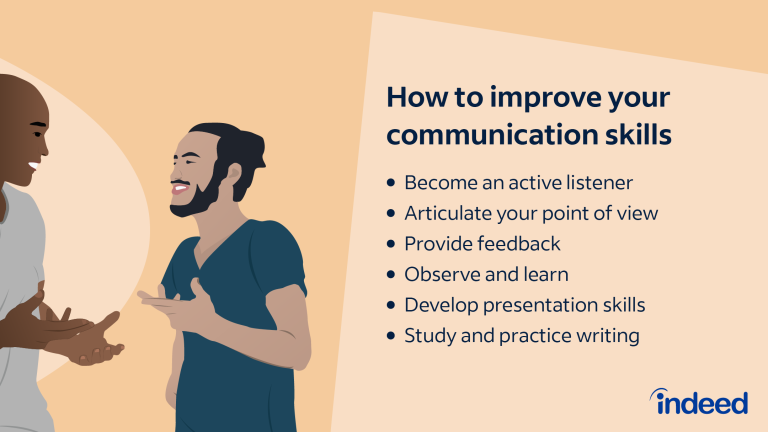What is Ineffective Communication
Ineffective communication is the failure to convey information or ideas clearly and efficiently. It hampers understanding and creates confusion among individuals or groups.
Misinterpretation, misunderstandings, and lack of feedback are common consequences of ineffective communication. Effective communication plays a crucial role in successful interactions, both in personal and professional settings. It ensures clarity, understanding, and fosters productive relationships. On the other hand, ineffective communication can lead to distrust, conflict, and hinder progress.
This can occur due to various reasons such as language barriers, poor listening skills, non-verbal cues, or insufficient information sharing. Recognizing the signs of ineffective communication is essential to address issues promptly and improve overall communication dynamics. We will explore the impact of ineffective communication, discuss common barriers, and provide practical tips to enhance communication effectiveness in different contexts. Whether you are a student, professional, or simply interested in improving your communication skills, this guide offers valuable insights to help you overcome communication challenges and achieve better outcomes.
The Importance Of Effective Communication
Effective communication is vital in both personal and professional relationships as it allows individuals to express their thoughts, feelings, and ideas clearly and concisely. It helps in understanding each other better, fostering trust and respect, and resolving conflicts efficiently. Without effective communication, misunderstandings can arise, leading to confusion, frustration, and even strained relationships.
In personal relationships, effective communication builds strong bonds, promotes intimacy, and ensures mutual understanding. In a professional setting, it facilitates collaboration, increases productivity, and promotes a positive work environment. Through effective communication, individuals can convey their expectations, receive feedback, and align their goals with others.
It also enables individuals to convey their needs and preferences effectively, minimizing the chances of errors or dissatisfaction. Therefore, mastering the art of effective communication is essential for success and fulfillment in both personal and professional spheres.

Credit: www.proofhub.com
Common Causes Of Ineffective Communication
Ineffective communication can be caused by several factors. One common cause is the lack of clarity and conciseness in the message being conveyed. When information is unclear or too lengthy, it becomes difficult for the recipient to understand the intended meaning.
Additionally, misinterpretation of non-verbal cues can lead to misunderstandings and ineffective communication. People often rely on body language and facial expressions to convey messages, but these can be easily misread or misunderstood. Emotional barriers can also hinder effective communication, as strong emotions can cloud judgment and create biased perceptions.
Lastly, cultural differences play a significant role in communication breakdowns. Different cultural norms and values can lead to misunderstandings and misinterpretations of messages. Understanding and overcoming these common causes of ineffective communication is crucial for promoting clear and effective interpersonal interactions.
The Impact Of Ineffective Communication
Ineffective communication can have a significant impact on various aspects of our lives. Misunderstandings and conflicts arise when messages are unclear or not properly conveyed. These can lead to strained relationships and a lack of trust amongst individuals. Additionally, productivity and efficiency are hindered as important information is lost or misunderstood.
When communication breaks down, tasks take longer to complete, and quality may suffer. This can negatively affect both personal and professional relationships, as well as overall team dynamics. It is crucial to recognize the consequences of ineffective communication and strive for clearer, more concise exchanges of information.
By doing so, misunderstandings can be minimized, productivity can be enhanced, and relationships can flourish. Improved communication skills are essential for success in all aspects of life, and they can be developed through self-awareness, active listening, and continuous practice.
Non-Verbal Communication
Ineffective communication can often be attributed to a lack of understanding of non-verbal cues. These cues, such as body language, facial expressions, and gestures, play a crucial role in conveying messages. By observing and interpreting these cues, we can better understand the true intentions and emotions behind someone’s words.
For example, a furrowed brow might indicate confusion or concern, while a smile could signify happiness or agreement. By paying attention to these cues, we can avoid miscommunication and bridge the gap between what is said and what is truly meant.
So, next time you engage in a conversation, remember to not only listen to the words, but also observe the non-verbal cues that can provide deeper insights into the message being conveyed.
Verbal Communication
Verbal communication involves recognizing unclear or ambiguous messages and identifying ineffective listening skills. It is essential to pay attention to both verbal cues and nonverbal signals to ensure effective communication. Unclear or ambiguous messages can disrupt understanding and create confusion in conversations.
Recognizing these patterns allows individuals to address the issues and clarify any miscommunication promptly. In addition, identifying ineffective listening skills, such as interrupting, failing to ask clarifying questions, or being distracted, can help improve overall communication. By being aware of these barriers, individuals can work towards enhancing their communication skills and fostering meaningful and productive conversations.
Effective verbal communication is crucial in both personal and professional settings, enabling individuals to convey their thoughts, ideas, and emotions clearly and efficiently.
Communication Styles
Effective communication is essential for building strong relationships and achieving desired outcomes. However, ineffective communication can hinder collaboration and create misunderstandings. Communication styles play a crucial role in determining the effectiveness of our interactions. Passive behavior involves avoiding confrontation and deferring to others excessively.
Aggressive behavior, on the other hand, is characterized by hostility and dominance. Passive-aggressive behavior combines elements of both passivity and aggression, resulting in indirect expressions of negativity. These communication styles can have a detrimental impact on relationships and productivity. Defensive communication further exacerbates the problem, as it involves reacting to perceived threats by becoming defensive, dismissive, or hostile.
By understanding the various communication styles and the negative impact of defensive communication, individuals and organizations can take steps to foster effective and respectful communication.
Clear And Concise Communication
Ineffective communication refers to a lack of clarity and conciseness when conveying information. It is important to use precise language, avoiding any jargon or technical terms that may confuse the recipient. Summarizing and paraphrasing ideas can help ensure that the message is understood correctly.
By using clear and concise language, the sender can avoid misunderstandings and promote effective communication. It is crucial to keep sentences brief and to the point, allowing the message to be easily understood. Effective communication fosters collaboration and understanding, while ineffective communication can lead to confusion and frustration.
By following these guidelines, individuals can improve their communication skills and ensure that their messages are received and understood as intended.
Active Listening Techniques
Ineffective communication occurs when individuals fail to actively listen and engage in meaningful dialogue. Active listening techniques, such as giving full attention and maintaining eye contact, play a crucial role in effective communication. By focusing entirely on the speaker and avoiding distractions, one can show genuine interest and create a conducive environment for open communication.
Reflecting and clarifying information also enhances communication by ensuring that both parties have a clear understanding of the message being conveyed. Using open-ended questions encourages the speaker to provide detailed responses, leading to a deeper level of communication. These techniques not only improve understanding but also foster trust and mutual respect.
By implementing active listening strategies, individuals can overcome the barriers of ineffective communication and build strong connections with others. Successful communication is key to achieving personal and professional growth, and it starts with active listening.
Empathy And Emotional Intelligence
Ineffective communication is often caused by a lack of empathy and emotional intelligence. By understanding others’ perspectives and actively listening, we can avoid misunderstandings and conflicts. It is important to control our emotions and manage conflicts in a calm and respectful manner.
Showing empathy and understanding towards others allows for effective communication and promotes healthy relationships. It is crucial to be aware of the impact our words and actions have on others, and to respond in a way that considers their feelings and needs.
Developing empathy and emotional intelligence improves our communication skills and fosters productive and harmonious interactions with those around us.
Effective Verbal Communication
Ineffective communication refers to the failure to convey information or ideas clearly and efficiently. It hinders understanding and can lead to misunderstandings and conflicts. Effective verbal communication is essential in various aspects of life, including personal relationships and professional interactions.
One way to enhance communication skills is by employing assertive communication techniques. This involves expressing thoughts and feelings confidently in a respectful manner. Another important aspect is delivering feedback constructively, focusing on improvement rather than criticism. Building rapport and trust is also crucial in effective communication, creating a positive and open atmosphere for meaningful exchanges.
By improving these communication skills, individuals can avoid misunderstandings, enhance relationships, and achieve success in personal and professional endeavors.
Non-Verbal Communication Skills
Ineffective communication refers to a lack of effective exchange of information, ideas, or emotions. Non-verbal communication skills play a crucial role in this aspect. One of the key aspects is utilizing appropriate body language. Engaging in active non-verbal communication can help convey messages effectively without solely relying on words.
It involves gestures, facial expressions, posture, and eye contact. These cues can enhance understanding and establish a stronger connection between individuals. For instance, maintaining good eye contact shows attentiveness and interest. Similarly, using open and welcoming body language can make others feel comfortable and encourage open dialogue.
Overall, honing non-verbal communication skills is essential for avoiding misunderstandings and fostering effective communication in various contexts.
Cultural Awareness In Communication
Effective communication is crucial in any setting, and cultural awareness plays a significant role in achieving it. By recognizing and respecting cultural differences, we can enhance our communication skills. It involves understanding the norms and values of different cultures and adapting our communication styles accordingly.
This awareness enables us to avoid misunderstandings and ensures that our messages are received in the intended manner. It is essential to be mindful of language barriers, non-verbal cues, and different communication preferences that may exist. By being culturally aware, we can foster inclusivity and create an open environment where everyone’s perspectives are valued.
Improving cultural awareness in communication leads to more effective interactions and promotes harmony between diverse individuals and communities.
Addressing Language Barriers
Ineffective communication can arise due to language barriers, which can hinder understanding and cooperation. To address this issue, language translation and interpretation techniques play a vital role. Utilizing visual aids and examples can greatly enhance comprehension and make the communication process more effective.
These techniques help bridge the gap between different languages and cultures, facilitating clearer and more accurate communication. By offering visual representations and practical examples, communication can become more accessible and engaging for all parties involved. Such approaches enable individuals to understand concepts and messages more easily, minimizing confusion and misunderstandings.
Addressing language barriers through language translation and interpretation techniques, along with visual aids and examples, is crucial for effective communication in a diverse and globalized world.
Overcoming Emotional Barriers
Ineffective communication can hinder the progress and success of any relationship or organization. Overcoming emotional barriers is crucial in promoting open and honest communication. By encouraging individuals to express their thoughts and feelings without fear of judgment, a safe space is created for effective dialogue.
Building psychological safety further contributes to open communication, as it assures individuals that their opinions and ideas are valued and respected. This fosters an environment of trust and collaboration, where people feel comfortable sharing their perspectives and working towards common goals.
Effective communication is essential for building strong relationships, resolving conflicts, and achieving desired outcomes. By addressing emotional barriers and promoting open and honest dialogue, individuals and organizations can overcome communication challenges and create a culture of transparency and mutual understanding.
Improving Listening Skills
Ineffective communication can hinder effective interaction between individuals. Improving listening skills is crucial in overcoming this barrier. Practicing active listening techniques boosts comprehension and shows respect for the speaker. By minimizing distractions, such as putting away electronic devices and maintaining eye contact, one can be fully engaged in the conversation.
Being present in the moment and focusing on the speaker’s words enhances understanding and connection. Additionally, attentive listening allows for thoughtful responses and effective problem-solving. In this fast-paced world, it is important to prioritize active listening, as it fosters effective communication and strengthens relationships.
So, let’s make a conscious effort to improve our listening skills and minimize communication gaps for better interpersonal connections.
Frequently Asked Questions Of What Is Ineffective Communication
What Is An Example Of Ineffective Communication?
An example of ineffective communication is when two people are not able to understand each other’s messages clearly. This can happen when one person uses complex language or technical jargon that the other person does not understand. It can also happen when there are distractions or noise that make it difficult to hear or focus on the conversation.
Ineffective communication can lead to misunderstandings, confusion, and frustration. For example, if a supervisor gives vague instructions to an employee, the employee may not be able to complete the task correctly, leading to mistakes and delays. Ineffective communication can also occur in written form, such as when an email or memo is poorly written and does not convey the intended message clearly.
Overall, ineffective communication hinders the exchange of ideas, information, and understanding between people.
How Do You Identify Ineffective Communication?
Ineffective communication can be identified through various signs. One indicator is when information is unclear or confusing, making it difficult to understand the message being conveyed. When there are frequent misunderstandings or misinterpretations, it is a sign of ineffective communication.
Another red flag is when there is a lack of engagement or interest from the receiver, indicating that the message has not resonated with them. Additionally, if there is a failure to achieve the desired outcome or objectives, it suggests that communication has been ineffective.
Lack of feedback or response from the receiver can also indicate ineffective communication. In conclusion, ineffective communication can be recognized by unclear information, misunderstandings, disengagement, failure to achieve objectives, and lack of feedback.
What Is An Example Of Ineffective Communication In The Workplace?
Ineffective communication in the workplace can be seen when team members fail to listen actively or ask for clarification. This can lead to misunderstandings, delays, and mistakes. For example, if a manager provides ambiguous instructions, employees may not understand the expectations and could end up completing tasks incorrectly.
Poorly written emails or memos with confusing language can also contribute to ineffective communication. When team members do not communicate their ideas or concerns clearly and confidently, it can hinder collaboration and problem-solving. These communication breakdowns can affect morale, productivity, and the overall success of a company.
Therefore, it is crucial for individuals to practice effective communication skills such as speaking clearly, actively listening, and seeking clarification when necessary.
What Five Factors Can Cause Ineffective Communication?
Ineffective communication can be caused by several factors: poor listening skills, lack of clarity in the message, distractions, language barriers, and misunderstandings. Improper listening can lead to misinterpretation and confusion. Messages that are not clear and concise can cause misunderstandings or miscommunication.
Distractions such as noise or interruptions can disrupt the flow of communication. Language barriers may make it challenging for individuals to understand each other. Lastly, misunderstandings can occur when different parties perceive the same message differently. To improve communication effectiveness, individuals should practice active listening, use clear and concise language, minimize distractions, bridge language gaps with appropriate tools or interpreters, and clarify any misunderstandings promptly.
By addressing these factors, effective communication can be fostered, enhancing understanding and collaboration amongst individuals.
Conclusion
In a nutshell, ineffective communication can cause a myriad of problems in both personal and professional relationships. It can lead to misunderstandings, conflicts, and missed opportunities. When communication lacks clarity, intention, and active listening, it hinders the ability to convey messages effectively and connect with others.
The absence of proper communication channels and tools can further exacerbate the issue, making it challenging to exchange ideas and collaborate efficiently. To mitigate the negative impact of ineffective communication, it is crucial to cultivate strong communication skills. This includes actively listening, using clear and concise language, and employing appropriate non-verbal cues.
Additionally, embracing technology and utilizing platforms that facilitate communication can greatly enhance interactions and promote effective collaboration. Recognizing the signs of ineffective communication and actively working to improve it is crucial for personal growth, professional success, and maintaining healthy relationships.
By consistently striving to enhance our communication skills, we can bridge gaps and foster stronger connections with others, leading to heightened understanding, increased productivity, and overall satisfaction in our interactions.



